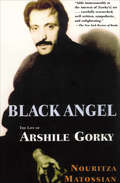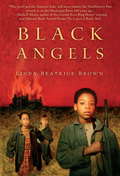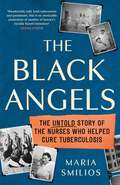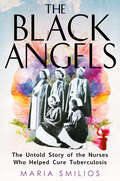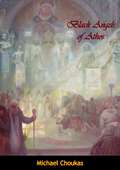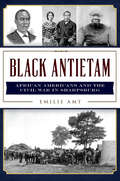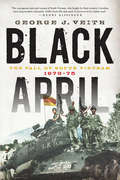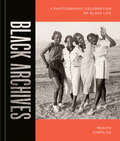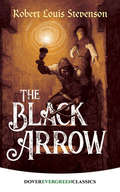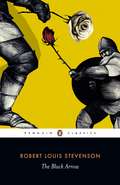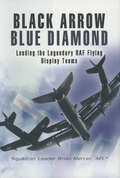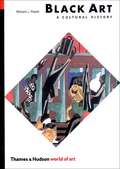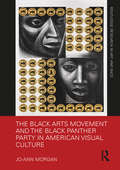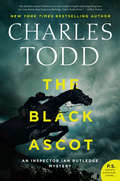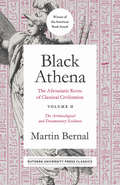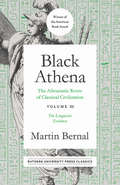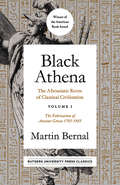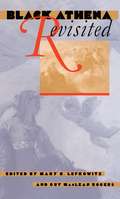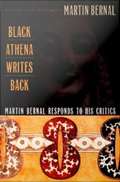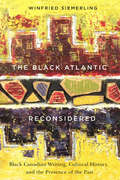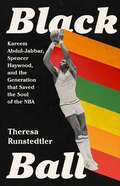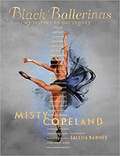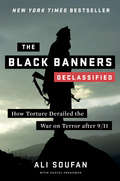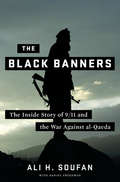- Table View
- List View
Black Angel: The Life of Arshile Gorky
by Nouritza MatossianA biography of the Armenian painter that “adds immeasurable to the interest of [his] art . . . Carefully researched, well written, [and] enlightening” (The New York Review of Books). In this first full-scale biography, Nouritza Matossian charts the mysterious and tragic life of Arshile Gorky, one of the most influential painters of the twentieth century. Born Manoug Adoian in Armenia, he survived the Turkish genocide of 1915 before coming to America, where he posed as a cousin of the famous Russian author Maxim Gorky. One of the first abstract expressionists, Gorky became a major figure of the New York School, which included de Kooning, Rothko, Pollock, and others. But after a devastating series of illnesses, injuries, and personal setbacks, he committed suicide at the age of forty-six. In Black Angel, arts journalist Matossian analyzes Gorky’s personal letters, as well as other new source material. She writes with authority, insight, and compassion about the powerful influence Gorky’s life and Armenian heritage had upon his painting.
Black Angels
by Linda Beatrice BrownThe compelling story of three young orphans who must survive on their own during the Civil War. It?s near the end of the war, and rumors of emancipation are swirling. Eleven-year-old Luke decides to run away to freedom and join the Union Army. But he doesn?t find the Yankee troops he was hoping for. Instead, he finds nine-year-old Daylily, lost in the woods after suffering an unspeakable tragedy. Her master set her free, but freedom so far has her scared and alone. Also lost in the woods is seven-year-old Caswell, the son of a plantation owner. He was only trying to find his Mamadear after the Yankees burned their house with all their fine things. He wanted to be brave. But alone in the woods with two slave children, he quickly loses all his courage, and comes to greatly depend upon his new friends. In the chaos and violence that follows, the three unrelated children discover a bond in each other stronger than family. A touching, beautifully written narrative, Black Angels is a riveting, special read. .
The Black Angels: The Untold Story of the Nurses Who Helped Cure Tuberculosis
by Maria SmiliosNew York City, 1929. A sanatorium, a deadly disease, and a dire nurse shortage.So begins the remarkable true story of the Black nurses who helped cure tuberculosis, one of the world's deadliest plagues, told alongside the often strange chronicle of the cure's discovery.During those dark pre-antibiotic days, when tuberculosis killed 1 in 7 people, white nurses at Sea View, New York's largest municipal hospital, began quitting. Desperate to avert a public health crisis, city officials summoned Black southern nurses, luring them with promises of good pay, a career, and an escape from the strictures of Jim Crow. But after arriving, they found themselves on an isolated hilltop in the remote borough of Staten Island, yet again confronting racism and consigned to a woefully understaffed facility, dubbed 'the pest house' where 'no one left alive'.Spanning the Great Depression and moving through World War II and beyond, this story follows the intrepid young women, the 'Black Angels', who, for twenty years, risked their lives working under dreadful conditions while caring for the city's poorest - 1,800 souls languishing in wards, waiting to die or become 'guinea pigs' for experimental (often deadly) drugs. Yet despite their major role in desegregating the NYC hospital system - and vital work in the race for the cure for tuberculosis and subsequently helping to find it at Sea View - these nurses were completely erased from history. The Black Angels recovers the voices of these extraordinary women and puts them at the centre of this riveting story celebrating their legacy and spirit of survival.
The Black Angels: The Untold Story of the Nurses Who Helped Cure Tuberculosis
by Maria SmiliosNew York City, 1929. A sanatorium, a deadly disease, and a dire nursing shortage. In the pre-antibiotic days when tuberculosis stirred people&’s darkest fears, killing one in seven, white nurses at Sea View, New York&’s largest municipal hospital, began quitting en masse. Desperate to avert a public health crisis, city officials summoned Black southern nurses, luring them with promises of good pay, a career, and an escape from the strictures of Jim Crow. But after arriving, they found themselves on an isolated hilltop in the remote borough of Staten Island, yet again confronting racism and consigned to a woefully understaffed sanatorium, dubbed &“the pest house,&” where it was said that &“no one left alive.&” Spanning the Great Depression and moving through World War II and beyond, this remarkable true story follows the intrepid young women known by their patients as the &“Black Angels.&” For twenty years, they risked their lives working under appalling conditions while caring for New York&’s poorest residents, who languished in wards, waiting to die, or became guinea pigs for experimental surgeries and often deadly drugs. But despite their major role in desegregating the New York City hospital system—and their vital work in helping to find the cure for tuberculosis at Sea View—these nurses were completely erased from history. The Black Angels recovers the voices of these extraordinary women and puts them at the center of this riveting story, celebrating their legacy and spirit of survival.
Black Angels of Athos
by Michael ChoukasPRESERVED against vital change by the salt of ancient religious tradition, there exist within the modern world various communities which still live the authentic life of dead centuries. Of such none has been more remarkable, more continuous, and more rich in sociological interest than the celibate medieval community of Mt. Athos. Its millennial resistance to the forces of changing civilizations has led various writers to give an account of it, but no study has heretofore been made which attempts a sociological analysis of its organization and of the forces at work within it. Mr. Choukas has essayed this task. He possessed the initial combination of qualities prerequisite for the undertaking. Greek by origin and competent in the language, sympathetic in approach, discerning, sociologically trained, he equipped himself for the task by residence on the Holy Mountain. We may be grateful that before the now manifest forces of disintegration have undermined this most stubborn stronghold of an ancient order we can look on the picture he presents to us of its daily manner of life, of the relation between ideal and practice, of the problems of its celibate segregation, of the forces and schisms within it, of the impacts from without, and of the spirit in which it responds.What is perhaps most significant to the sociologist in the whole picture is the manner in which this monastic society is organized to maintain its solidarity and its tradition in face of all the impulses of human beings which were against it. ...As we read Mr. Choukas’ account we pass from the external scene of peaceful retreats on austere heights to the more intimate view of an obdurate and dubious struggle waged within themselves by men of simple childlike minds, oblivious, it may be, of the real issues of this age-old fight which they think of as that between “the flesh” and “the spirit,”...
Black Antietam: African Americans and the Civil War in Sharpsburg (Civil War Series)
by Emilie AmtRead the story of the Battle of Antietam from the African American perspective.The African American community around Sharpsburg, Maryland witnessed John Brown's raid, wartime skirmishes, the Battle of South Mountain, and the aftermath of the bloodiest day in American history. Read stories of encounters with Abraham Lincoln and Union and Confederate generals, and of Black civilian suffering and sacrifice in the cause of freedom. Their experiences during four years of Civil War come to life in vivid detail, often in their own words. Award-winning historian Emilie Amt recounts the personal stories of African Americans, both enslaved and free, who lived on the battlefield and who worked in the armies who clashed there.
Black April
by George J VeithThe defeat of South Vietnam was arguably America's worst foreign policy disaster of the 20th Century. Yet a complete understanding of the endgame-from the 27 January 1973 signing of the Paris Peace Accords to South Vietnam's surrender on 30 April 1975-has eluded us.Black April addresses that deficit. A culmination of exhaustive research in three distinct areas: primary source documents from American archives, North Vietnamese publications containing primary and secondary source material, and dozens of articles and numerous interviews with key South Vietnamese participants, this book represents one of the largest Vietnamese translation projects ever accomplished, including almost one hundred rarely or never seen before North Vietnamese unit histories, battle studies, and memoirs. Most important, to celebrate the 30th Anniversary of South Vietnam's conquest, the leaders in Hanoi released several compendiums of formerly highly classified cables and memorandum between the Politburo and its military commanders in the south. This treasure trove of primary source materials provides the most complete insight into North Vietnamese decision-making ever complied. While South Vietnamese deliberations remain less clear, enough material exists to provide a decent overview.Ultimately, whatever errors occurred on the American and South Vietnamese side, the simple fact remains that the country was conquered by a North Vietnamese military invasion despite written pledges by Hanoi's leadership against such action. Hanoi's momentous choice to destroy the Paris Peace Accords and militarily end the war sent a generation of South Vietnamese into exile, and exacerbated a societal trauma in America over our long Vietnam involvement that reverberates to this day. How that transpired deserves deeper scrutiny.
Black Archives: A Photographic Celebration of Black Life
by Renata CherliseA photographic celebration and exploration of Black identity and experience through the twentieth century from the founder and curator of the hit multimedia platform Black Archives.&“A spell-binding visual narrativization of family, culture, and history.&”—Thelma Golden, director and chief curator of the Studio Museum in HarlemRenata Cherlise&’s family loved capturing their lives in photographs and home movies, sparking her love of archival photography. Following in her family&’s footsteps, Cherlise established Black Archives, which presents a nuanced representation of Black people across time living vibrant, ordinary lives. Through the platform, many have discovered and shared images of themselves and their loved ones experiencing daily life, forming multidimensional portraits of people, places, and the Black community. These photographs not only tell captivating stories, they hold space for collective memory and kinship. Black Archives is a stunning collection of timeless images that tell powerful, joyful stories of everyday life and shed light on Black culture&’s dynamic, enduring influence through the generations. The images showcase reunions, nights out on the town, parents and children, church and school functions, holidays, big life events, family vacations, moments at home, and many more occasions of leisure, excitement, reflection, and pride. Featuring more than three hundred images that spotlight the iconic and the candid, Black Archives offers a nuanced compendium of Black memory and imagination.
The Black Arrow: A Tale Of The Two Roses (Dover Children's Evergreen Classics)
by Robert Louis StevensonSet in England during the fifteenth-century Wars of the Roses, this swashbuckling historical novel by the author of Treasure Island and Kidnapped tells the story of young Dick Shelton. Betrayed by his treacherous and brutal guardian, Sir Daniel Brackley, Dick seeks the help of John Amend-All, leader of the mysterious fellowship of the Black Arrow—and Brackley's sworn enemy. Pitted against fierce fighters, a treacherous priest, and Sir Daniel, Dick seeks to become a knight and rescue his true love. Brimming with adventure, suspense, and romance, this thrilling tale presents a classic portrait of England during one of its most tumultuous eras, as Dick is pulled by his loyalties to the houses of both York and Lancaster. He must make a crucial choice, for his fate and the fate of England hang in the balance.
The Black Arrow
by Robert Louis StevensonCaught in the midst of England's War of the Roses, young Dick Shelton's loyalties are torn between a guardian who betrays him and the leader of the secret fellowship, "The Black Arrow". the Houses of York and Lancaster are locked in a brutal struggle for England's crown and the fate of the kingdom is at stake. Shelton finds himself entangled in the conspiracy. In order to survive he must distinguish friend from foe and confront the tests of war, shipwreck, murder and forbidden love.
Black Arrow Blue Diamond: Leading the Legendary RAF Flying Display Teams
by Brian MercerBrian Mercer is one of the most outstanding post-war RAF fighter pilots and in this eminently readable autobiography he recaptures life as it was in the days of transition from flying piston-powered aircraft to jet power. His flying and leadership skills resulted in a long association with what was then considered as the finest aerobatic display team in the world—Treble One Squardrons Black Arrows. Flying the elegant black Hawker Hunters in large formation displays was no easy task and the author explains in great detail how their legendary precision was achieved, revealing many exciting incidents en route. When Treble Ones Hunters were replaced with the supersonic Lightining fighter, it soon became clear that these superfast aircraft were not suited to close-up display flying. Brian was then asked to form a new RAF display team and continue with Hunters. This was to become the No. 92 Squadrons Blue Diamonds, who inherited the star role. Faced with the fact that future promotion within the RAF would move him from cockpit to desk, Brian elected to join then then fledgling airline, Cathay Pacific. His story continues with many exciting incidents flying from the companys home base at Kai Tak in Hong Kong.
Black Art: A Cultural History
by Richard J. PowellThe African diaspora, "a direct result of the transatlantic slave trade and Western colonialism," generated a wide array of artistic achievements in the past century, from blues to reggae, from the paintings of Henry Ossawa Tanner to the video installations of Keith Piper. Richard Powell's study concentrates on the works of art themselves and on how these works, created during a time of major social upheaval and transformation, use black culture as both subject and context. From musings on the "the souls of black folk" in early twentieth-century painting, sculpture, and photography to questions of racial and cultural identities in performance, media, and computer-assisted arts in the 1990s, the book draws on the works of hundreds of artists including Jean-Michel Basquiat, Romare Bearden, Elizabeth Catlett, Lois Mailou Jones, Wifredo Lam, Jacob Lawrence, Spike Lee, Archibald Motley, Jr. , Faith Ringgold, and Gerard Sekoto. This revised edition includes expanded coverage of video art and a new chapter that discusses work by a number of artists who have newly risen to prominence, such as Chris Ofili, Kara Walker, and Ren e Cox. Biographies of more than 170 key artists provide a unique art-historical reference. Placing its emphasis on black cultural themes rather than on black racial identity, this groundbreaking book is an important exploration of the visual representations of black culture throughout the twentieth century and into the twenty-first.
The Black Arts Movement and the Black Panther Party in American Visual Culture (Routledge Research in Art and Race)
by Jo-Ann MorganThis book examines a range of visual expressions of Black Power across American art and popular culture from 1965 through 1972. It begins with case studies of artist groups, including Spiral, OBAC and AfriCOBRA, who began questioning Western aesthetic traditions and created work that honored leaders, affirmed African American culture, and embraced an African lineage. Also showcased is an Oakland Museum exhibition of 1968 called "New Perspectives in Black Art," as a way to consider if Black Panther Party activities in the neighborhood might have impacted local artists’ work. The concluding chapters concentrate on the relationship between selected Black Panther Party members and visual culture, focusing on how they were covered by the mainstream press, and how they self-represented to promote Party doctrine and agendas.
The Black Ascot: Inspector Ian Rutledge Mysteries #21 (Inspector Ian Rutledge Mysteries #21)
by Charles ToddScotland Yard’s Ian Rutledge seeks a killer who has eluded Scotland Yard for years in this next installment of the acclaimed New York Times bestselling series.An astonishing tip from a grateful ex-convict seems implausible—but Inspector Ian Rutledge is intrigued and brings it to his superior at Scotland Yard. Alan Barrington, who has evaded capture for ten years, is the suspect in an appalling murder during Black Ascot, the famous 1910 royal horse race meet honoring the late King Edward VII. His disappearance began a manhunt that consumed Britain for a decade. Now it appears that Barrington has returned to England, giving the Yard a last chance to retrieve its reputation and see justice done. Rutledge is put in charge of a quiet search under cover of a routine review of a cold case. Meticulously retracing the original inquiry, Rutledge begins to know Alan Barrington well, delving into relationships and secrets that hadn’t surfaced in 1910. But is he too close to finding his man? His sanity is suddenly brought into question by a shocking turn of events. His sister Frances, Melinda Crawford, and Dr. Fleming stand by him, but there is no greater shame than shell shock. Questioning himself, he realizes that he cannot look back. The only way to save his career—much less his sanity—is to find Alan Barrington and bring him to justice. But is this elusive murderer still in England?
Black Athena: The Afroasiatic Roots of Classical Civilization Volume II: The Archaeological and Documentary Evidence
by Martin BernalBlack Athena, an audacious three-volume series, strikes at the heart of today's most heated culture wars. Martin Bernal challenges Eurocentric attitudes by calling into question conventional explanations for the origins of classical civilization. Provocative, passionate, and colossal in scope, this thoughtful rewriting of history continues to stir academic and political controversy.
Black Athena: The Afroasiatic Roots of Classical Civilization Volume II: The Archaeological and Documentary Evidence
by Martin BernalWhat is classical about Classical civilization? In one of the most audacious works of scholarship ever written, Martin Bernal challenges the foundation of our thinking about this question. Classical civilization, he argues, has deep roots in Afroasiatic cultures. But these Afroasiatic influences have been systematically ignored, denied or suppressed since the eighteenth century—chiefly for racist reasons. The popular view is that Greek civilization was the result of the conquest of a sophisticated but weak native population by vigorous Indo-European speakers—Aryans—from the North. But the Classical Greeks, Bernal argues, knew nothing of this “Aryan model.” They did not see their institutions as original, but as derived from the East and from Egypt in particular. This long-awaited third and final volume of the series is concerned with the linguistic evidence that contradicts the Aryan Model of ancient Greece. Bernal shows how nearly 40 percent of the Greek vocabulary has been plausibly derived from two Afroasiatic languages – Ancient Egyptian and West Semitic. He also reveals how these derivations are not limited to matters of trade, but extended to the sophisticated language of politics, religion, and philosophy. This evidence, according to Bernal, greatly strengthens the hypothesis that in Greece an Indo-European-speaking population was culturally dominated by Ancient Egyptian and West Semitic speakers. Provocative, passionate, and colossal in scope, this volume caps a thoughtful rewriting of history that has been stirring academic and political controversy since the publication of the first volume.
Black Athena: The Afroasiatic Roots of Classical Civilization Volume I: The Fabrication of Ancient Greece 1785-1985
by Martin BernalWhat is classical about Classical civilization? In one of the most audacious works of scholarship ever written, Martin Bernal challenges the foundation of our thinking about this question. Classical civilization, he argues, has deep roots in Afroasiatic cultures. But these Afroasiatic influences have been systematically ignored, denied or suppressed since the eighteenth century—chiefly for racist reasons. The popular view is that Greek civilization was the result of the conquest of a sophisticated but weak native population by vigorous Indo-European speakers—Aryans—from the North. But the Classical Greeks, Bernal argues, knew nothing of this “Aryan model.” They did not see their institutions as original, but as derived from the East and from Egypt in particular. In an unprecedented tour de force, Bernal links a wide range of areas and disciplines—drama, poetry, myth, theological controversy, esoteric religion, philosophy, biography, language, historical narrative, and the emergence of “modern scholarship.”
Black Athena Revisited
by Mary R. Lefkowitz Guy Maclean RogersWas Western civilization founded by ancient Egyptians and Phoenicians? Can the ancient Egyptians usefully be called black? Did the ancient Greeks borrow religion, science, and philosophy from the Egyptians and Phoenicians? Have scholars ignored the Afroasiatic roots of Western civilization as a result of racism and anti-Semitism? In this collection of twenty essays, leading scholars in a broad range of disciplines confront the claims made by Martin Bernal in Black Athena: The Afroasiatic Roots of Classical Civilization. In that work, Bernal proposed a radical reinterpretation of the roots of classical civilization, contending that ancient Greek culture derived from Egypt and Phoenicia and that European scholars have been biased against the notion of Egyptian and Phoenician influence on Western civilization. The contributors to this volume argue that Bernal's claims are exaggerated and in many cases unjustified. Topics covered include race and physical anthropology; the question of an Egyptian invasion of Greece; the origins of Greek language, philosophy, and science; and racism and anti-Semitism in classical scholarship. In the conclusion to the volume, the editors propose an entirely new scholarly framework for understanding the relationship between the cultures of the ancient Near East and Greece and the origins of Western civilization. The contributors are: John Baines, professor of Egyptology, University of Oxford Kathryn A. Bard, assistant professor of archaeology, Boston University C. Loring Brace, professor of anthropology and curator of biological anthropology in the Museum of Anthropology, University of Michigan John E. Coleman, professor of classics, Cornell University Edith Hall, lecturer in classics, University of Reading, England Jay H. Jasanoff, Jacob Gould Schurman Professor of Linguistics, Cornell University Richard Jenkyns, fellow and tutor, Lady Margaret Hall, Oxford, and university lecturer in classics, University of Oxford Mary R. Lefkowitz, Andrew W. Mellon Professor in the Humanities, Wellesley College Mario Liverani, professor of ancient near eastern history, Universita di Roma, 'La Sapienza' Sarah P. Morris, professor of classics, University of California at Los Angeles Robert E. Norton, associate professor of German, Vassar College Alan Nussbaum, associate professor of classics, Cornell University David O'Connor, professor of Egyptology and curator in charge of the Egyptian section of the University Museum, University of Pennsylvania Robert Palter, Dana Professor Emeritus of the History of Science, Trinity College, Connecticut Guy MacLean Rogers, associate professor of Greek and Latin and history, Wellesley College Frank M. Snowden, Jr., professor of classics emeritus, Howard University Lawrence A. Tritle, associate professor of history, Loyola Marymount University Emily T. Vermeule, Samuel E. Zemurray, Jr., and Doris Zemurray Stone-Radcliffe Professor Emerita, Harvard University Frank J. Yurco, Egyptologist, Field Museum of Natural History and the University of Chicago
Black Athena Writes Back: Martin Bernal Responds to his Critics
by David Chioni Moore Martin BernalIn Black Athena Writes Back Martin Bernal responds to the passionate debates set off by the 1987 publication of his book Black Athena. Producing a shock wave of reaction from scholars, Black Athena argued that the development of Greek civilization was heavily influenced by Afroasiatic civilizations. Moreover, Bernal asserted that this knowledge had been deliberately obscured by the rampant racism of nineteenth-century Europeans who could not abide the notion that Greek society--for centuries recognized as the originating culture of Europe--had its origins in Africa and Southwest Asia. The subsequent rancor among classicists over Bernal's theory and accusations was picked up in the popular media, and his suggestion that Greek culture had its origin in Africa was widely derided. In a report on 60 Minutes, for example, it was suggested that Bernal's hypothesis was essentially an attempt to provide blacks with self-esteem so that they would feel included in the march of progress. In Black Athena Writes Back Bernal provides additional documentation to back up his thesis, as well as offering persuasive explanations of why traditional scholarship on the subject remains inaccurate and why specific arguments lobbed against his theories are themselves faulty. Black Athena Writes Back requires no prior familiarity with either the Black Athena hypothesis or with the arguments advanced against it. It will be essential reading for those who have been following this long-running debate, as well as for those just discovering this fascinating subject.
The Black Atlantic Reconsidered: Black Canadian Writing, Cultural History, and the Presence of the Past (ISSN)
by Winfried SiemerlingReaders are often surprised to learn that black writing in Canada is over two centuries old. Ranging from letters, editorials, sermons, and slave narratives to contemporary novels, plays, poetry, and non-fiction, black Canadian writing represents a rich body of literary and cultural achievement. The Black Atlantic Reconsidered is the first comprehensive work to explore black Canadian literature from its beginnings to the present in the broader context of the black Atlantic world. Winfried Siemerling traces the evolution of black Canadian witnessing and writing from slave testimony in New France and the 1783 "Book of Negroes" through the work of contemporary black Canadian writers including George Elliott Clarke, Austin Clarke, Dionne Brand, David Chariandy, Wayde Compton, Esi Edugyan, Marlene NourbeSe Philip, and Lawrence Hill. Arguing that black writing in Canada is deeply imbricated in a historic transnational network, Siemerling explores the powerful presence of black Canadian history, slavery, and the Underground Railroad, and the black diaspora in the work of these authors. Individual chapters examine the literature that has emerged from Quebec, Nova Scotia, the Prairies, and British Columbia, with attention to writing in both English and French. A major survey of black writing and cultural production, The Black Atlantic Reconsidered brings into focus important works that shed light not only on Canada's literature and history, but on the transatlantic black diaspora and modernity.
Black Ball: Kareem Abdul-Jabbar, Spencer Haywood, and the Generation that Saved the Soul of the NBA
by Theresa RunstedtlerA vital narrative history of 1970s pro basketball, and the Black players who shaped the NBA Against a backdrop of ongoing resistance to racial desegregation and strident calls for Black Power, the NBA in the 1970s embodied the nation&’s imagined descent into disorder. A new generation of Black players entered the league then, among them Kareem Abdul-Jabbar and Spencer Haywood, and the press and public were quick to blame this cohort for the supposed decline of pro basketball, citing drugs, violence, and greed. Basketball became a symbol for post-civil rights America: the rules had changed, allowing more Black people onto the playing field, and now they were ruining everything. Enter Black Ball, a gripping history and corrective in which scholar Theresa Runstedtler expertly rewrites basketball&’s &“Dark Ages.&” Weaving together a deep knowledge of the game with incisive social analysis, Dr. Runstedtler argues that this much-maligned period was pivotal to the rise of the modern-day NBA. Black players introduced an improvisational style derived from the playground courts of their neighborhoods. They also challenged the team owners&’ autocratic power, garnering higher salaries and increased agency. Their skills, style, and savvy laid the foundation for the global popularity and profitability of the league we know today.
Black Ballerinas
by Misty CopelandFrom New York Times bestselling and award-winning author and American Ballet Theatre principal dancer Misty Copeland comes an illustrated nonfiction collection celebrating dancers of color who have influenced her on and off the stage. <p><p> As a young girl living in a motel with her mother and her five siblings, Misty Copeland didn’t have a lot of exposure to ballet or prominent dancers. She was sixteen when she saw a black ballerina on a magazine cover for the first time. The experience emboldened Misty and told her that she wasn’t alone—and her dream wasn’t impossible. <p> In the years since, Misty has only learned more about the trailblazing women who made her own success possible by pushing back against repression and racism with their talent and tenacity. Misty brings these women’s stories to a new generation of readers and gives them the recognition they deserve. <p> With an introduction from Misty about the legacy these women have had on dance and on her career itself, this book delves into the lives and careers of women of color who fundamentally changed the landscape of American ballet from the early 20th century to today.
The Black Banners: How Torture Derailed The War On Terror After 9/11 (Playaway Adult Nonfiction Ser.)
by Ali SoufanThe definitive account of an FBI special agent’s al-Qaeda story, unredacted for the first time. Widely heralded on publication as a "must-read" (Military Review) and "important window on America’s battle with al-Qaeda" (Washington Post), Ali Soufan’s revelatory account of the war on terror as seen from its front lines changed the way we understand al-Qaeda and how the United States prosecuted the war—and led to hard questions being asked of our leaders. When The Black Banners was published in 2011, significant portions of the text were redacted. After subsequent review by the Central Intelligence Agency, those redactions have been lifted. Their removal corrects the record on how vital intelligence was obtained from al-Qaeda suspects and brings forth important new details on the controversial use of enhanced interrogation techniques (torture) to extract information from terror suspects. For many years, proponents of the use of these techniques have argued that they produced actionable intelligence in the war on terror. This edition of The Black Banners explodes this myth; it shows Soufan at work using guile and intelligent questioning—not force or violence—to extract some of the most important confessions in the war, and it vividly recounts the failures of the government’s torture program. Drawing on Soufan’s experiences as a lead operative for the FBI and declassified government records, The Black Banners (Declassified) documents the intelligence failures that lead to the tragic attacks on New York and Washington, DC, and subsequently how torture derailed the fight against al-Qaeda. With this edition, eighteen years on from the first sanctioned enhanced interrogation technique, the public can finally read the complete story of what happened in their name after the events of 9/11. The Black Banners (Declassified) includes a new foreword from Ali Soufan that addresses the significance of the CIA’s decision to lift the redactions.
The Black Banners: The Inside Story of 9/11 and the War Against al-Qaeda
by Ali H. Soufan Daniel FreedmanA book that will change the way we think about al-Qaeda, intelligence, and the events that forever changed America. On September 11, 2001, FBI Special Agent Ali H. Soufan was handed a secret file. Had he received it months earlier--when it was requested--the attacks on New York and Washington could have been prevented. During his time on the front lines, Soufan helped thwart plots around the world and elicited some of the most important confessions from terrorists in the war against al-Qaeda--without laying so much as a hand on them. Most of these stories have never been reported before, and never by anyone with such intimate firsthand knowledge. This narrative account of America's successes and failures against al-Qaeda is essential to an understanding of the terrorist group. We are taken into hideouts and interrogation rooms. We have a ringside seat at bin Laden's personal celebration of the 9/11 bombings. Such riveting details show us not only how terrorists think and operate but also how they can be beaten and brought to justice.
